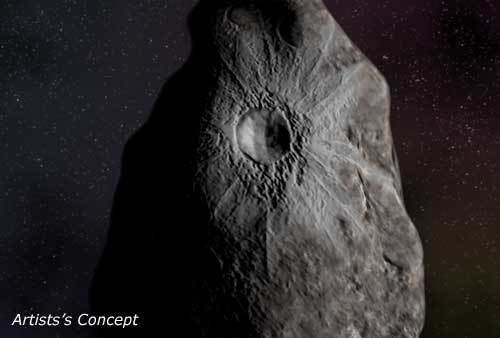Alternative names 1995 GO Orbital period 76 years Orbits Sun | Discovery date 5 April 1995 Pronunciation (/ˈæzbələs/ Discovered 5 April 1995 | |
 | ||
Discovery site Kitt Peak National Observatory Similar James V Scotti discoveries, Other celestial objects | ||
8405 asbolus centaur s crater
8405 Asbolus (/ˈæzbələs/; from Greek: Άσβολος), provisionally designated 1995 GO, is a centaur orbiting in the Outer Solar System between the orbits of Jupiter and Neptune. It was discovered on 5 April 1995, by James Scotti and Robert Jedicke of Spacewatch (credited) at Kitt Peak Observatory in Arizona, United States. It is named after Asbolus, a centaur in Greek mythology and measures approximately 80 kilometers in diameter.
Centaurs have short dynamical lifetimes due to perturbations by the giant planets. Asbolus is estimated to have an orbital half-life of about 860 kiloannum. Asbolus is currently classified as a SN centaur since Saturn is considered to control the perihelion and Neptune controls the aphelion. It currently has a perihelion of 6.8 AU, so is also influenced by Jupiter. Centaurs with a perihelion less than 6.6 AU are very strongly influenced by Jupiter and for classification purposes are considered to have a perihelion under the control of Jupiter. In about ten thousand years, clones of the orbit of Asbolus suggest that its perihelion classification may come under the control of Jupiter.
Predicting the overall orbit and position of Asbolus beyond a few thousand years is difficult because of errors in the known trajectory, error amplification by perturbations due to all of the gas giants, and the possibility of perturbation as a result of cometary outgassing and fragmentation. Compared to centaur 7066 Nessus, the orbit of Asbolus is currently much more chaotic.
No resolved images of it have ever been made, but in 1998 spectral analysis of its composition by the Hubble Space Telescope revealed a fresh impact crater on its surface, less than 10 million years old. Centaurs are dark in colour, because their icy surfaces have darkened after long exposure to solar radiation and the solar wind. However, fresh craters excavate more reflective ice from below the surface, and that is what Hubble has detected on Asbolus.
The minor planet was named from Greek mythology after Asbolus (Greek for "sooty", "the black one"), a centaur capable to read omens in the flight of birds. He provoked a bloodbath in which the centaurs Chiron and Pholus met their deaths at Heracles' hands. The minor planets 2060 Chiron, 5145 Pholus and 5143 Heracles are named after these mythological figures. Naming citation was published on 28 September 1999 (M.P.C. 36128).
